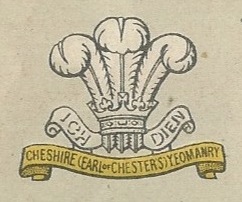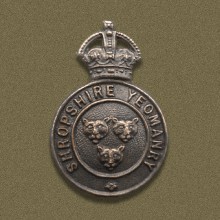
The Cheshire Yeomanry was a yeomanry regiment that can trace its history back to 1797 when Sir John Leicester of Tabley raised a county regiment of light cavalry in response to the growing fears of invasion from Napoleonic France. Its lineage is maintained by C Squadron, the Queen's Own Yeomanry.

The Shropshire Yeomanry was a yeomanry regiment of the British Army, first raised in 1795, which served as a cavalry and dismounted infantry regiment in the First World War and as a cavalry and an artillery regiment in the Second World War. It was then amalgamated with the Shropshire Royal Horse Artillery.
The 3rd Mounted Division was a Yeomanry Division of the British Army active during World War I. It was formed on 6 March 1915 as the 2/2nd Mounted Division, a replacement/depot formation for the 2nd Mounted Division which was being sent abroad on active service. In March 1916, it was renumbered as the 3rd Mounted Division and in July 1916 as the 1st Mounted Division. In September 1917, the division was reorganized as a cyclist formation and redesignated as The Cyclist Division. It remained in the United Kingdom throughout the war and was disbanded in June 1919.
The 1st Mounted Division was a Yeomanry Division of the British Army active during World War I. It was formed in August 1914 for the home defence of the United Kingdom from four existing mounted brigades of the Territorial Force, each of three regiments of Yeomanry. The divisional order of battle changed often, as the 1st Line brigades left for service overseas and were replaced by 2nd Line formations. It was converted to the 1st Cyclist Division in July 1916, and was broken up in November 1916 without being involved in active service. It remained in East Anglia throughout its existence.
The Denbighshire Hussars was a Welsh Yeomanry regiment of the British Army formed in 1794. It saw service in the First World War before being converted into a unit of the Royal Artillery. The lineage has been continued by 398 Squadron, Royal Logistic Corps.
The 4th Mounted Division was a short-lived Yeomanry Division of the British Army active during World War I. It was formed on 20 March 1916, converted to 2nd Cyclist Division in July 1916 and broken up on 16 November 1916. It remained in England on Home Defence duties throughout its existence.
The Yorkshire Mounted Brigade was a formation of Britain's part-time Territorial Force organised in 1908. Mobilised on the outbreak of World War I, its regiments had been posted away by 1915 so it was broken up. It never saw active service.
The Eastern Mounted Brigade was a formation of the Territorial Force of the British Army, organised in 1908. After serving dismounted in the Gallipoli Campaign, it was absorbed into the 3rd Dismounted Brigade in Egypt in February 1916.

The British yeomanry during the First World War were part of the British Army reserve Territorial Force. Initially, in 1914, there were fifty-seven regiments and fourteen mounted brigades. Soon after the declaration of war, second and third line regiments were formed. However, the third line regiments were soon absorbed into the Cavalry Reserve Regiments, to supply replacements for the cavalry and yeomanry. Other horsed regiments in the British Army, during the war, were the regular cavalry regiments and the three regiments belonging to the special reserve: the North Irish Horse, the South Irish Horse and the King Edward's Horse. The senior yeomanry regiments could trace their origins back over 100 years; the oldest regiment, the Royal Wiltshire Yeomanry, had been formed in 1794. The most junior regiment, the Welsh Horse, had only been formed on 18 August 1914, after the start of the war.
The Royal 1st Devon Yeomanry was a Yeomanry regiment of the British Army. First raised in 1794, it participated in the Second Boer War and the First World War before being amalgamated with the Royal North Devon Yeomanry in 1920 to form the Royal Devon Yeomanry.
The Scottish Horse Mounted Brigade was a formation of the Territorial Force of the British Army, raised in August 1914, during the First World War. After service in the Gallipoli Campaign and in the defence of Egypt, it was absorbed into the 1st Dismounted Brigade in February 1916.
The 21st Mounted Brigade previously known as the 2/1st Western Mounted Brigade was a 2nd Line yeomanry brigade of the British Army during the First World War. In July 1916 it was converted to a cyclist formation as 14th Cyclist Brigade and in October 1916 was redesignated as 10th Cyclist Brigade. It was still in existence, in Ireland, at the end of the war.
The 20th Mounted Brigade previously known as the 2/1st Lowland Mounted Brigade was a 2nd Line yeomanry brigade of the British Army during the First World War. In July 1916 it was converted to a cyclist formation as 13th Cyclist Brigade and in November 1916 was redesignated as 9th Cyclist Brigade. It was still in existence, in Ireland, at the end of the war.
The 2nd South Western Mounted Brigade was a formation of the Territorial Force of the British Army, organised in 1908. After service in the Gallipoli Campaign and in the defence of Egypt, it was absorbed into the 2nd Dismounted Brigade in February 1916.
The Welsh Border Mounted Brigade was a formation of the Territorial Force of the British Army, organised in 1908. After home defence service, it was posted to Egypt, where it was absorbed into the 4th Dismounted Brigade in March 1916.
The South Wales Mounted Brigade was a formation of the Territorial Force of the British Army, organised in 1908. After home defence service, it was posted to Egypt, where it was absorbed into the 4th Dismounted Brigade in March 1916.
The Yeomanry Mounted Brigade was a formation of the Territorial Force of the British Army, raised in January 1915 during the First World War. After service in the Gallipoli Campaign and with the Western Frontier Force in World War I, it was broken up in March 1916.
The Glamorganshire Royal Horse Artillery was a Territorial Force Royal Horse Artillery battery that was formed in Glamorganshire in 1908. It saw active service during the First World War on the Western Front in 1917 and 1918 as part of an Army Field Artillery Brigade. A second line battery, 2/1st Glamorganshire RHA, served in England and Ireland before being broken up in January 1917. Glamorganshire RHA was not reconstituted in the post-war Territorial Force.
The Somerset Royal Horse Artillery was a Territorial Force Royal Horse Artillery battery that was formed in Somerset in 1908. It saw active service during the First World War in the Sinai and Palestine Campaign with the ANZAC Mounted Division from 1916 to 1918. A second line battery, 2/1st Somerset RHA, served on the Western Front with the 63rd Division from 1916 to 1918. It was disembodied after the end of the war and was not reconstituted in the Territorial Force in 1920.
The Shropshire Royal Horse Artillery was a Territorial Force Royal Horse Artillery battery that was formed in Shropshire in 1908 from the Shropshire Battery of the 1st Shropshire and Staffordshire Artillery Volunteers, Royal Garrison Artillery of the Volunteer Force. It saw active service during the First World War on the Western Front in 1917 and 1918 as part of an Army Field Artillery Brigade. A second line battery, 2/1st Shropshire RHA, also served on the Western Front in 1917 and 1918 as part of another Army Field Artillery Brigade. It was reconstituted post-war as a medium artillery battery and served as such in the Second World War.


